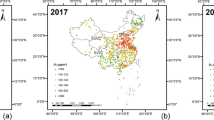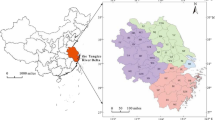Abstract
Ozone (O3) pollution has a profound impact on human health, vegetation development, and the ecological environment, making it a critical focus of global academic research. In recent years, O3 pollution in China has been on a steady rise, with ozone emerging as the sole conventional pollutant to consistently increase in concentration without any decline. This study conducted a quantitative analysis of O3 concentrations across 367 Chinese cities in 2019, examining spatial autocorrelation and local clustering of O3 levels, and investigated the diverse relationships between human activity factors and O3 concentration. The seasonal fluctuation of O3 exhibited the “M-type” pattern, with peak concentrations in winter and the lowest levels in summer. The center of O3 pollution migrated southeastward, with the area of highest concentration progressively shifting south along the eastern coast. Moreover, O3 concentration showed a strong positive correlation with population density, road freight volume, and industrial emissions, suggesting that human activities, vehicle emissions, and industrial operations are significant contributors to O3 production. The results provide comprehensive information on the characteristics, causes, and occurrence mechanism of O3 in Chinese cities that can be utilized by global government departments to formulate strategies to prevent and control O3 pollution.







Similar content being viewed by others
Data availability
Data will be made available on request.
References
Anselin L, Kelejian HH (1997) Testing for spatial error autocorrelation in the presence of endogenous regressors. Int Reg Sci Rev. 20(1–2):153–182.
Anselin L, Bera AK, Florax R, Yoon MJ (1996) Simple diagnostic tests for spatial dependence. Reg Sci Urban Econ. 26(1):77–104.
Ayanlade A, Sergi CM, Sakdapolrak P, Ayanlade OS, Di Carlo P, Babatimehin OI, Lemlem FW, Jegede MO (2022) Climate change engenders a better early warning system development across Sub-Saharan Africa: The malaria case. Resour Environ Sustain. 10:100080.
Brunsdon C, Fotheringham AS, Charlton ME (1996) Geographically weighted regression: A method for exploring spatial nonstationarity. Geogr Anal. 28(4):281–298.
Burke DT, Hynds P, Priyadarshini A (2023) Quantifying farm-to-fork greenhouse gas emissions for five dietary patterns across Europe and north America: A pooled analysis from 2009 to 2020. Resour Environ Sustain. 12:100108.
Dang R, Liao H, Fu Y (2021) Quantifying the anthropogenic and meteorological influences on summertime surface ozone in China over 2012–2017. Sci Total Environ. 754:142394.
Dhakal C, Khadka S, Park C, Escalante CL (2022) Climate change adaptation and its impacts on farm income and downside risk exposure. Resour Environ Sustain. 10:100082.
Dubin RA (1998) Spatial autocorrelation: a Primer. J Hous Econ. 7(4):304–327.
Fan H, Zhao C, Yang Y (2020) A comprehensive analysis of the spatio-temporal variation of urban air pollution in China during 2014–2018. Atmos Environ. 220:117066. https://doi.org/10.1016/j.atmosenv.2019.117066
Hao Y, Liu YM (2016) The influential factors of urban PM2.5 concentrations in China: A spatial econometric analysis. J Clean Prod. 112:1443–1453.
Kang D, Hogrefe C, Foley KL, Napelenok SL, Mathur R, Rao ST (2013) Application of the Kolmogorov-Zurbenko filter and the decoupled direct 3D method for the dynamic evaluation of a regional air quality model. Atmos Environ. 80:58–69.
Li G, Fang C, Wang S, Sun S (2016) The effect of economic growth, urbanization, and industrialization on fine particulate matter (PM2.5) concentrations in China. Environ Sci Technol. 50(21):11452–11459.
Li N, He Q, Greenberg J, Guenther A, Li J, Cao J, Wang J, Liao H, Wang Q, Zhang Q (2018) Impacts of biogenic and anthropogenic emissions on summertime ozone formation in the Guanzhong Basin. China Atmos Chem Phys. 18(10):7489–7507.
Li K, Jacob DJ, Liao H, Shen L, Zhang Q, Bates KH (2019) Anthropogenic drivers of 2013–2017 trends in summer surface ozone in China. Proc Natl Acad Sci. 116(2):422–427.
Liang L, Liu N, Landis MS, Xu X, Feng X, Chen Z, Shang Li, Qiu G (2018) Chemical characterization and sources of PM2.5 at 12-h resolution in Guiyang, China. Acta Geochim. 37:334–345.
Liu T, Li TT, Zhang YH, Xu YJ, Lao XQ, Rutherford S, Chu C, Luo Y, Zhu Q, Xu XJ, **e YH, Liu ZR, Ma WJ (2013) The short-term effect of ambient ozone on mortality is modified by temperature in Guangzhou. China Atmos Environ. 76:59–67.
Liu X, Li S, Wang Z, Han G, Li J, Wang B, Wang F, Bai L (2017) Nitrous oxide (N2O) emissions from a mesotrophic reservoir on the Wujiang river, southwest China. Acta Geochim. 36:667–679.
Liu H, Zhang M, Han X (2020) A review of surface ozone source apportionment in China. Atmos Ocean Sci Lett. 13(5):470–484.
Liu L, Xu L, Wang S, Tian X (2023) The transition patterns of rural household carbon footprint in China. Resour Environ Sustain. 13:100122.
Lun X, Lin Y, Chai F, Fan C, Li H, Liu J (2020) Reviews of emission of biogenic volatile organic compounds (BVOCs) in Asia. J Environ Sci. 95:266–277.
Marquaridt DW (1970) Generalized inverses, ridge regression, biased linear estimation, and nonlinear estimation. Technometrics. 12(3):591–612.
Njoku EA, Akpan PE, Effiong AE, Babatunde IO (2023) The effects of station density in geostatistical prediction of air temperatures in Sweden: A comparison of two interpolation techniques. Resour Environ Sustain. 11:100092.
Ord JK, Getis A (1995) Local spatial autocorrelation statistics: Distributional issues and an application. Geogr Anal. 27(4):286–306.
Streets DG, Fu JS, Jang CJ, Hao J, He K, Tang X, Zhang YH, Wang ZF, Li ZP, Zhang Q, Wang LT, Wang BY, Yu C (2007) Air quality during the 2008 Bei**g Olympic games. Atmos Environ. 41(3):480–492.
Tan-Soo JS, Finkelstein E, Pattanayak S, Qin P, Zhang X, Jeuland M (2022) Air quality valuation using online surveys in three Asian megacities. Resour Environ Sustain. 10:100090.
Wang T, Xue L, Brimblecombe P, Lam YF, Li L, Zhang L (2017) Ozone pollution in China: A review of concentrations, meteorological influences, chemical precursors, and effects. Sci Total Environ. 575:1582–1596.
Wang P, Guo H, Hu J, Kota SH, Ying Q, Zhang H (2019) Responses of PM2.5 and O3 concentrations to changes of meteorology and emissions in China. Sci Total Environ. 662:297–306.
Wang Y, Duan X, Liang T, Wang L, Wang L (2022) Analysis of spatio-temporal distribution characteristics and socioeconomic drivers of urban air quality in China. Chemosphere. 291:132799.
Wei W, Cheng S, Wang L, Ji D, Zhou Y, Han L, Wang L (2015) Characterizing ozone pollution in a petrochemical industrial area in Bei**g, China: A case study using a chemical reaction model. Environ Monit Assess. 187(6):1–10.
Wolf K, Cyrys J, Harciníková T, Gu J, Kusch T, Hampel R, Schneider A, Peters A (2017) Land use regression modeling of ultrafine particles, ozone, nitrogen oxides and markers of particulate matter pollution in Augsburg. Germany Sci Total Environ. 579:1531–1540.
**ao K, Wang Y, Wu G, Fu B, Zhu Y (2018) Spatiotemporal characteristics of air pollutants (PM10, PM2.5, SO2, NO2, O3, and CO) in the inland basin city of Chengdu southwest China. Atmosphere. 9(2):74.
Yin CQ, Solmon F, Deng XJ, Zou Y, Deng T, Wang N, Li F, Mai BR, Liu L (2019) Geographical distribution of ozone seasonality over China. Sci Total Environ. 689:625–633.
Yue T, Tong Y, Gao J, Yuan Y, Wang L, Wei H (2024) High-precision spatio-temporal variations and future perspectives of multiple air pollutant emissions from Chinese biomass-fired industrial boilers. Sci Total Environ. 907:167982.
Zhang R, Lei W, Tie X, Hess P (2004) Industrial emissions cause extreme urban ozone diurnal variability. Proc Natl Acad Sci. 101(17):6346–6350.
Funding
This work was supported by National Natural Science Foundation of China (grant number 42101318), the National Key R&D Program of China (grant number 2018YFD1100101).
Author information
Authors and Affiliations
Contributions
YW: Investigation, Methodology, Formal analysis, Visualization, Writing—Original draft; WZ: Investigation, Methodology, Visualization; YL: Visualization, Investigation; YW: Conceptualization, Methodology, Writing—Reviewing and Editing, Supervision; ZF: Data Curation, Writing—Reviewing and Editing; YF: Formal analysis, Data Curation, Writing—Reviewing and Editing; LW: Conceptualization, Supervision, Writing—Reviewing and Editing.
Corresponding author
Ethics declarations
Conflict of interest
The authors declare that they have no known competing financial interests or personal relationships that could have appeared to influence the work reported in this paper.
Supplementary Information
Below is the link to the electronic supplementary material.
Rights and permissions
Springer Nature or its licensor (e.g. a society or other partner) holds exclusive rights to this article under a publishing agreement with the author(s) or other rightsholder(s); author self-archiving of the accepted manuscript version of this article is solely governed by the terms of such publishing agreement and applicable law.
About this article
Cite this article
Wang, Y., Zhang, W., Liu, Y. et al. Study on the spatial and temporal evolutionary characteristics of ozone concentration and the impact of human activities in China in 2019. Acta Geochim (2024). https://doi.org/10.1007/s11631-024-00695-1
Received:
Revised:
Accepted:
Published:
DOI: https://doi.org/10.1007/s11631-024-00695-1




